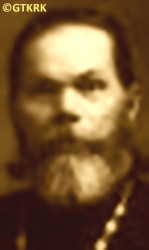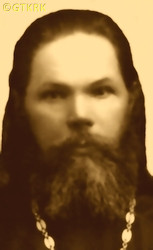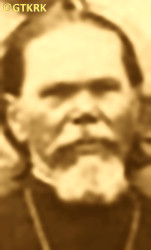Roman Catholic
St Sigismund parish
05-507 Słomczyn
85 Wiślana Str.
Konstancin deanery
Warsaw archdiocese, Poland
full list:
displayClick to display full list

searchClick to search full list by categories
wyświetlKliknij by wyświetlić pełną listę po polsku

szukajKliknij by przeszukać listę wg kategorii po polsku

Martyrology of the clergy — Poland
XX century (1914 – 1989)
personal data
surname
SURWIŁŁO
forename(s)
Hermolaus

function
presbiter (i.e. iereus)
creed
Eastern Orthodox Church ORmore on
en.wikipedia.org
[access: 2014.09.21]
diocese / province
Vilnius OR eparchymore on
ru.wikipedia.org
[access: 2020.09.24]
Vilnius‐Lida OR eparchy (Polish Autocephalous Orthodox Church PAOC)more on
pl.wikipedia.org
[access: 2023.04.02]
date and place
of death
19.08.1941

Toropetstoday: Toropets urban, Toropets reg., Tver oblast, Russia
more on
en.wikipedia.org
[access: 2024.01.26]
details of death
On 22.06.1941 — during World War II, which began with the German and Russian invasion of Poland in 09.1939 — the Germans attacked their erstwhile allies, the Russians. The territory of Lithuania — occupied by the Russians since 05.1940, including the part of Poland taken over by the Lithuanians in 10.1939 — was captured within a week, while the territory of Latvia — also occupied from 05.1940 by the Russians — till 10.07.1941.
His Leonpol parish, occupied by the Russians since 09.1939, was located near the border with Latvia. After the German attack, the Russians began to flee in panic to the east. Just before the Germans entered, arrested on 02/03.07.1941 by an NKVD unit from Dryssa, a town located on the other side of Dryssa river — according to family memories, he was returning from a funeral.
, in full church clothes (according to some sources, went to Dryssa voluntarily summoned by the NKVD).
Transported to the prison in Dryssa.
From there, the next day taken east, to Velikiye Luki, c. 200 km away.
There prob. interrogated and tortured — beaten to the point of unconsciousness and then revived by drenching in water. Forced to sign interrogation reports without reading them — prob. „confessed” to anti–Russian activities, in particular attempts to sabotage collective farms established by Russians.
Due to the rapid approach to Velikiye Luki of the Germans (the Germans captured it on 20.07.1941), transported out c. 70 km further east, to Toropec.
There officially arrested by agents of the genocidal Russian organization NKVD and brought before a military court of the 22nd Russian Army, defending this sector of the front.
Sentenced to death.
Murdered — 8 days before Toropec was captured by the Germans.
cause of death
murder
perpetrators
Russians
sites and events
06.1941 massacres (NKVD)Click to display the description, Ribbentrop‐MolotovClick to display the description
date and place
of birth
17.06.1868

Zanarochtoday: Zanaroch ssov., Myadzyel dist., Minsk reg., Belarus
more on
be.wikipedia.org
[access: 2024.01.26]
presbyter (holy orders)
ordination
1906

positions held
22.01.1927 – 1941
parish priest — Leonpoltoday: Uzmeny ssov., Myory dist., Vitebsk reg., Belarus
more on
be.wikipedia.org
[access: 2024.01.26] ⋄ Holy Trinity OR parish ⋄ Druyatoday: Druya ssov., Braslaw dist., Vitebsk reg., Belarus
more on
en.wikipedia.org
[access: 2021.09.29] OR deanery
from 17.03.1926
dean — Myadzyel Staryitoday: Myadzyel, Myadzyel ssov., Myadzyel dist., Minsk reg., Belarus
more on
en.wikipedia.org
[access: 2022.02.06] OR deanery — acting („ad interim”)
27.04.1924
protoiereus (Eng. first priest) — Polish Autocephalous Orthodox Church PACP — dignity conferment
1908 – 01.1927
parish priest — Slobodatoday: Sloboda ssov., Myadzyel dist., Minsk reg., Belarus
more on
pl.wikipedia.org
[access: 2024.01.26] ⋄ St Alexander Nevsky OR parish ⋄ Myadzyel Staryitoday: Myadzyel, Myadzyel ssov., Myadzyel dist., Minsk reg., Belarus
more on
en.wikipedia.org
[access: 2022.02.06] OR deanery — for many years resided in the nearby hamlet of Wesolucha, where prob. was still a wooden Orthodox church
1906 – 1908
parish priest — Rudaminatoday: Rudamina eld., Vilnius dist., Vilnius Cou., Lithuania
more on
en.wikipedia.org
[access: 2024.03.19] ⋄ Transfiguration of the Lord OR parish
1906
presbiter (Eng. priest, i.e. iereus) — Russian Orthodox Church — priesthood cheirotonia, i.e. ordination
23.10.1902 – 1906
psalmist — Zhelyadtoday: part of Zhukoini‐Zhelyadskie village, Mikhailishky ssov., Astravyets dist., Grodno reg., Belarus
more on
be.wikipedia.org
[access: 2024.01.26] ⋄ Introduction of the Mother of God to the Temple OR church — also: prefect of a primary school
c. 1891 – 1902
teacher — Zasvirtoday: Svir ssov., Myadzyel dist., Minsk reg., Belarus
more on
be-tarask.wikipedia.org
[access: 2024.01.19] ⋄ elementary school
1887 – 1891
teacher — Nestanishkitoday: Zhodishki ssov., Smarhon dist., Grodno reg., Belarus
more on
be.wikipedia.org
[access: 2024.01.26] ⋄ elementary school
till 1887
student — Maladzyechnatoday: Maladzyechna dist., Minsk reg., Belarus
more on
en.wikipedia.org
[access: 2022.01.06] ⋄ Teachers' Seminary
married — at least one daughter
sites and events
descriptions
06.1941 massacres (NKVD): After German attack of Russian‐occupied Polish territory and following that of Russia itself, before a panic escape, Russians murdered — in accordance with the genocidal order issued on 24.06.1941 by the Russian interior minister Lawrence Beria to murder all prisoners (formally „sentenced” for „counter‐revolutionary activities”, „anti‐Russian acts”, sabotage and diversion, and political prisoners „in custody”), held in NKVD‐run prisons in Russian occupied Poland, Lithuania, Latvia and Estonia — c. 40,000‐50,000 prisoners. In addition Russians murdered many thousands of victims arrested after German attack regarding them as „enemies of people” — those victims were not even entered into prisons’ registers. Most of them were murdered in massacres in the prisons themselves, the others during so‐called „death marches” when the prisoners were driven out east. After Russians departure and start of German occupation a number of spontaneous pogroms of Jews took place. Many Jews collaborated with Russians and were regarded as co‐responsible for prison massacres. (more on: en.wikipedia.orgClick to attempt to display webpage
[access: 2021.12.19])
Ribbentrop‐Molotov: Genocidal Russian‐German alliance pact between Russian leader Joseph Stalin and German leader Adolf Hitler signed on 23.08.1939 in Moscow by respective foreign ministers, Mr. Vyacheslav Molotov for Russia and Joachim von Ribbentrop for Germany. The pact sanctioned and was the direct cause of joint Russian and German invasion of Poland and the outbreak of the World War II in 09.1939. In a political sense, the pact was an attempt to restore the status quo ante before 1914, with one exception, namely the „commercial” exchange of the so‐called „Kingdom of Poland”, which in 1914 was part of the Russian Empire, fore Eastern Galicia (today's western Ukraine), in 1914 belonging to the Austro‐Hungarian Empire. Galicia, including Lviv, was to be taken over by the Russians, the „Kingdom of Poland” — under the name of the General Governorate — Germany. The resultant „war was one of the greatest calamities and dramas of humanity in history, for two atheistic and anti‐Christian ideologies — national and international socialism — rejected God and His fifth Decalogue commandment: Thou shall not kill!” (Abp Stanislav Gądecki, 01.09.2019). The decisions taken — backed up by the betrayal of the formal allies of Poland, France and Germany, which on 12.09.1939, at a joint conference in Abbeville, decided not to provide aid to attacked Poland and not to take military action against Germany (a clear breach of treaty obligations with Poland) — were on 28.09.1939 slightly altered and made more precise when a treaty on „German‐Russian boundaries and friendship” was agreed by the same murderous signatories. One of its findings was establishment of spheres of influence in Central and Eastern Europe and in consequence IV partition of Poland. In one of its secret annexes agreed, that: „the Signatories will not tolerate on its respective territories any Polish propaganda that affects the territory of the other Side. On their respective territories they will suppress all such propaganda and inform each other of the measures taken to accomplish it”. The agreements resulted in a series of meeting between two genocidal organization representing both sides — German Gestapo and Russian NKVD when coordination of efforts to exterminate Polish intelligentsia and Polish leading classes (in Germany called «Intelligenzaktion», in Russia took the form of Katyń massacres) where discussed. Resulted in deaths of hundreds of thousands of Polish intelligentsia, including thousands of priests presented here, and tens of millions of ordinary people,. The results of this Russian‐German pact lasted till 1989 and are still in evidence even today. (more on: en.wikipedia.orgClick to attempt to display webpage
[access: 2015.09.30])
sources
personal:
by.openlist.wikiClick to attempt to display webpage
[access: 2024.01.26], www.hram-miory.vitebsk.byClick to attempt to display webpage
[access: 2024.01.26], www.hram-miory.vitebsk.byClick to attempt to display webpage
[access: 2024.01.26]
bibliographical:
„Hierachy, clergy and employees of the Orthodox Church in the 19th‐21st centuries within the borders of the Second Polish Republic and post–war Poland”, Fr Gregory Sosna, M. Antonine Troc-Sosna, Warsaw–Bielsk Podlaski 2017
original images:
by.openlist.wikiClick to attempt to display webpage
[access: 2024.01.26], www.hram-miory.vitebsk.byClick to attempt to display webpage
[access: 2024.01.26], by.openlist.wikiClick to attempt to display webpage
[access: 2024.01.26]
LETTER to CUSTODIAN/ADMINISTRATOR
If you have an Email client on your communicator/computer — such as Mozilla Thunderbird, Windows Mail or Microsoft Outlook, described at WikipediaPatrz:
en.wikipedia.org, among others — try the link below, please:
LETTER to CUSTODIAN/ADMINISTRATORClick and try to call your own Email client
If however you do not run such a client or the above link is not active please send an email to the Custodian/Administrator using your account — in your customary email/correspondence engine — at the following address:

giving the following as the subject:
MARTYROLOGY: SURWIŁŁO Hermolaus
To return to the biography press below:
 Click to return to biography
Click to return to biography










